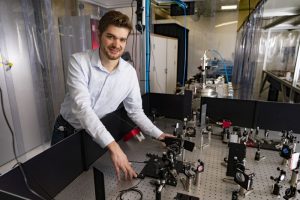Peter Kraus starting three interconnected projects

Over the past few months, group leader Peter Kraus saw three considerable grant proposals awarded that enable him to consolidate research projects for two different applications: the semiconductor industry and strongly correlated materials. The latter materials are theoretically predicted to behave as conductors, but then turn out to be insulators in experiments. Because of these properties they are of interest to be used in future microelectronics.
The NWO Open Technology Program (OTP) project ‘NANOXUV’, a collaboration with AMOLF group leader Femius Koenderink and industrial partner ASML aims at developing new methods to produce ultrafast (femtosecond) pulses to visualize nanometer scale structures. The semiconductor industry is expected to directly benefit from this research project. More information
The NWO ENW M2 project entitled ‘UltraX’ is a collaboration with Gertjan Koster (University of Twente) focuses on understanding the properties of correlated materials. Using ultrafast X-ray spectroscopy the researchers expect to learn more about the atomic and electronic structures that evolve during phase transition. More information
Finally, Kraus also received an NWO Vidi grant that ties the two previous projects together. The goal is to get a step closer to realize usage of correlated materials in the semiconductor industry. In order to do so the researchers aim to develop a new method to study nanostructures. The current standard is to generate light that has a wavelength smaller than the structure. This involves producing ultrashort wavelengths in a process called “high-harmonic generation”, the type of research for which the 2023 Nobel Prize in physics was awarded.
Kraus and his team are now adding a new approach. They intend to produce high harmonics directly from the solid nanostructure of interest, instead of making pulses from a gas. Applying a sequence of laser pulses they expect to be able to localize the harmonic emission at a specific and smaller zone and thereby achieve super resolution, improving what you would expect from the relatively long wavelength of the light pulses. This method is expected to be generally applicable as it does not require ‘labeling’ – that is chemical modifications of the sample. So far, there is a proof of principle that this approach should work, but experiments carried out in the coming years should prove that this is indeed a viable alternative.
More information








